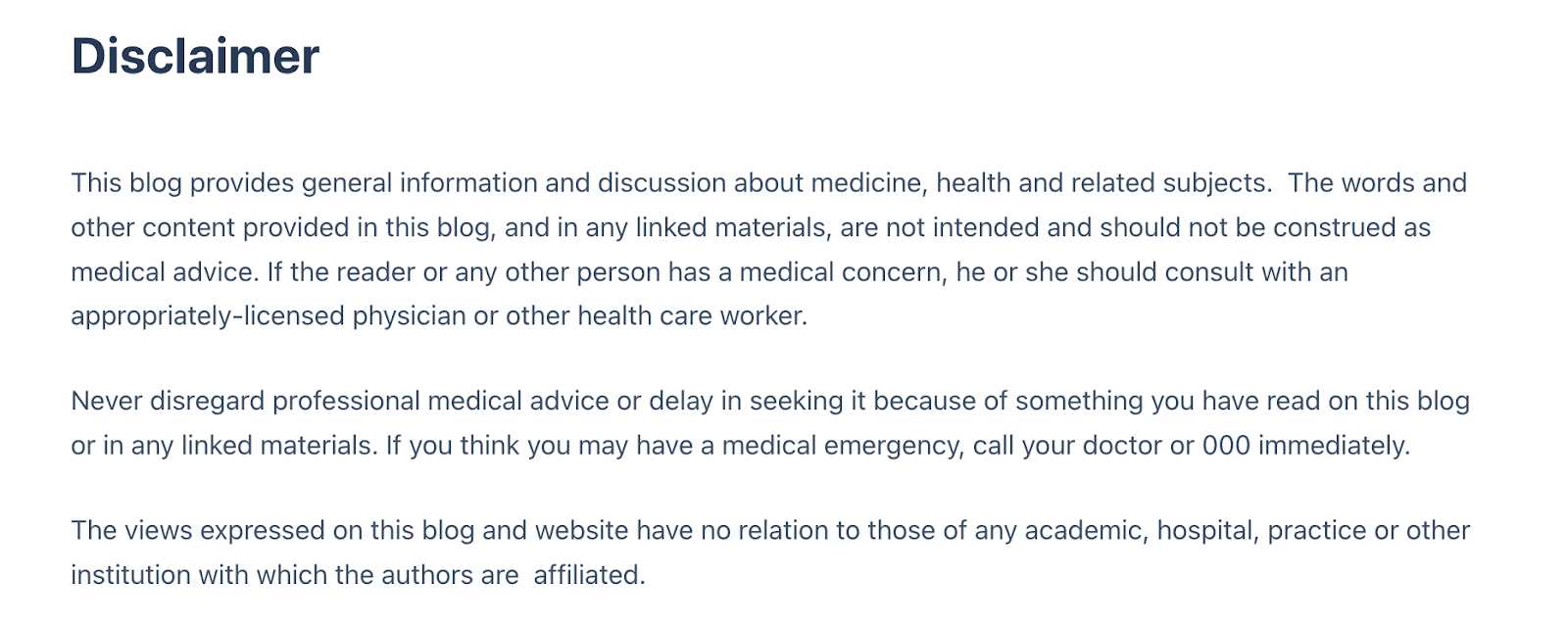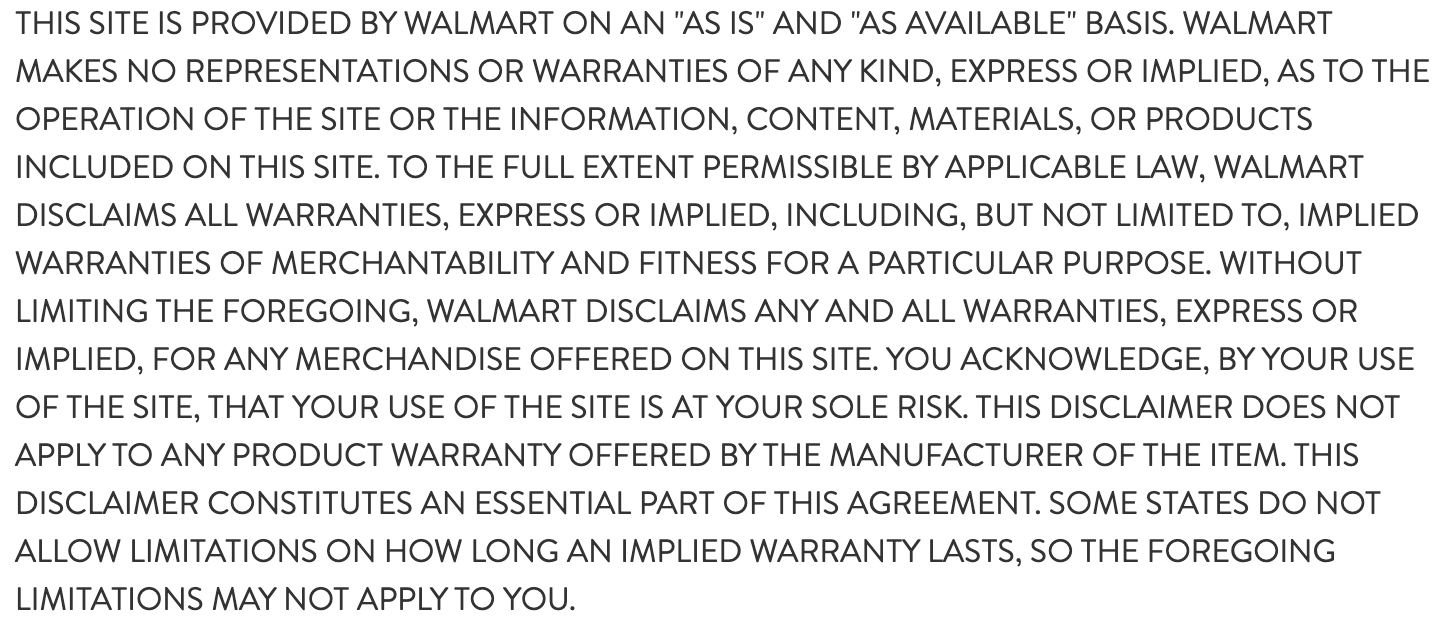After investing significant time, energy, and funds into establishing a business, one of your top priorities is to protect it. No-responsibility disclaimers are one of the easiest ways to guard against legal risks for your business.
A no-responsibility disclaimer — aka no-liability disclaimer — is a statement that helps prevent claims of civil liability by your customers.
Read on to learn more about no-responsibility disclaimers, see some examples, and learn how to create one.
What Is a No-responsibility Disclaimer?
A no-responsibility disclaimer is a statement that indicates you are not responsible for damages that result from the use of your product or service.
For example, on a website that deals with any advice related to health, you should include a disclaimer to indicate that content on the site does not take the place of a formal medical assessment by a doctor.
Whether you are writing a blog, selling a new tool for the kitchen, or offering your expertise in the form of advice, a no-liability disclaimer is an essential document for you and your customers.
Disclaimer of Liability and No-liability disclaimer
The no-responsibility disclaimer is also known as a “disclaimer of liability” — or “no-liability disclaimer” — because it refers to a lack of legal obligation on the part of you or your business.
These terms are used interchangeably, and posted disclaimers are sometimes labeled differently within the document.
For instance, a webpage might simply say “Limitations on Liability.” What follows that title, however, is still a no-responsibility disclaimer.
Consider this example of a disclaimer taken from a medical blog called Life in the Fastlane. Notice that it clearly points out that the information on the site is not a replacement for actual medical coverage:

Does a No-responsibility Disclaimer Offer Legal Protection?
A disclaimer isn’t a suit of armor that protects you from all potential litigation. For example, someone buys your product and then suffers an injury because you were negligent in the construction of that product, a disclaimer is unlikely to save you.
However, assuming you were not negligent, disclaimers are excellent support in your defense if you ever face legal action. If you can demonstrate that you notified the injured party in advance that you had no responsibility for damages, it will typically work in your favor.
On top of the evidence of your warning to customers, no-responsibility disclaimers are also a good way of deterring people from engaging in a legal battle in the first place.
They are less likely to sue if they know that you fairly warned them about potential consequences.
Consider this hypothetical scenario:
You wrote a blog post about how to avoid costly attorney fees by planning and managing your own divorce. The post describes the required forms and recommended strategies for the best possible financial outcomes.
Now imagine that someone followed your advice to the letter without confirming that there had been no changes or updates to the necessary forms. As it turns out, the courts changed the required documentation after you uploaded your post, the reader’s divorce has been delayed, and there are potential financial repercussions.
In this situation, the reader might try to blame you for offering flawed information, thus causing considerable emotional and financial suffering.
You would have much better protection against any claims of liability by the reader if you protected yourself by posting a disclaimer stating that:
Your suggestions do not constitute legal advice, and you cannot guarantee that the information is always up to date.
This statement will not necessarily stop a civil lawsuit from moving forward, but it will put you in a much better position to defend yourself before the court.
What Can Be Covered in a No-Responsibility Disclaimer?
The disclaimer you write for your business can be as detailed as you want it to be and can cover any or all of the goods or services you provide.
You should remember that goods can be:
- Tangible: Like an item or object
- Intangible: Such as advice or information
- Both: Like a book you have written that compiles your suggestions or ideas
In most cases, no-responsibility disclaimers protect you in specific ways:
- The accuracy of content or information
- Physical liability
- Third-party links
The coverage you will need depends entirely on your business and what it offers.
In short, if a customer suffers damages because you have been negligent, you will most likely be held legally responsible for those damages. For example, selling a product for small children you know is especially dangerous because you use low-quality materials.
Who Needs a No-Responsibility Disclaimer?
There are many situations in which a no-responsibility disclaimer is helpful. Any business, from marketers to bloggers to online merchants, could use a liability disclaimer in one form or another.
However, certain industries are particularly vulnerable to litigation, and in those situations, a disclaimer is even more crucial. These are usually businesses for which outdated or incorrect information can cause significant financial or emotional distress, or products can potentially cause substantial bodily harm.
No-Responsibility Disclaimer for Intangible Goods and Services
Although it seems like they would be less likely to lead to civil liability claims, intangible goods without disclaimers can quickly lead to trouble. After all, if someone misuses or over-relies on information, there can be enormous ramifications.
This is especially true in areas that affect financial and medical well-being, such as:
- Health, wellness, or medical advice
- Legal advice
- Financial advice
- Mental health information
- Workout programs
- Business building
- Life coaches
In each of these cases, the business disseminates information and recommendations that can be especially consequential for the customer.
For example, if a reader uses a recommended workout program without consulting a doctor, they might do something unsafe or beyond their body’s capabilities, resulting in a severe injury.
No-Responsibility Disclaimer for Tangible Goods and Services
When it comes to tangible goods, essentially any product can cause harm if it’s misused or by the wrong person. However, as with intangible goods, some categories are more troublesome than others, including:
- Products for children
- Vitamins and supplements
- Workout gear
- Tools and equipment
All of these items, even if they are perfectly designed and constructed, are capable of causing considerable physical harm.
A product-centric disclaimer indicating that customers assume the responsibility for any risks associated with the products helps safeguard you from liability.
Benefits of a No-Responsibility Disclaimer
Customers may interpret a disclaimer as a company trying to evade responsibility, but in reality, it should be beneficial for all parties.
At the same time that you are shielding your business from legal entanglements, you are also making it possible for customers to learn about any potential risks or damages related to your products or services.
In this way, they can approach the purchase or use of your goods with open eyes and total awareness.
Risks of Not Using a No-Responsibility Disclaimer
Disclaimers may not offer complete liability protection, but failing to use them leaves the door open for future civil litigation.
If you do not include a disclaimer, your customers can rightly state that you gave no warning that what you were offering could be damaging. Your failure to warn them may entitle them to compensation for the harm that they have suffered.
Furthermore, the failure to include an appropriate disclaimer increases the chance that a negative experience will occur. People deserve to be fully informed, and if the advice or item you offer can possibly cause someone to suffer in some way, you should tell them as much before moving forward.
No-Responsibility Disclaimer Examples
Examples of no-responsibility disclaimers are everywhere, which is no surprise, considering how critical they are to protecting your business.
The American Bar Association
This example, taken from the American Bar Association, makes clear that, even though it’s an especially authoritative source in the law, the site’s content is not equivalent to legal advice. At the same time, reading the information does not create any kind of client-attorney relationship.

It’s also a good demonstration of how to effectively protect yourself from the liability of third-party sites that your page may link to:
Walmart
The next example, taken from Walmart’s website, includes a variation of language frequently seen in disclaimers: “at your own risk.”
This phrase is a common way of expressing that the company has no responsibility for any damages that you may experience:

Essentially Yours
Finally, the vitamin and supplement company Essentially Yours has a no-liability disclaimer that clearly shows that it’s protecting itself from potential damages that may result from the use of its products:

How To Write a No-Responsibility Disclaimer
When you’re writing a no-responsibility disclaimer, one crucial thing to remember is how comprehensive it needs to be. In other words, carefully identify any tangible or intangible goods or services that a customer could argue caused damages and include those in your statement.
Your liability disclaimer will be most effective if it:
- Gets placed clearly and obviously on the page so that site visitors can find it easily
- Uses simple, straightforward language that will be easy for everyday users to comprehend
- Explains that your business is not responsible for any damages incurred from the use of your products or services
When considering the placement of your disclaimer, remember that it will be effective only if the user can actually find it. For that reason, disclaimers are frequently placed in a site’s footer or immediately after content or included within the terms of service.
Lastly, you should avoid using a generic or vague disclaimer, which would unlikely cover the points relevant to your business. The wording of your no-responsibility disclaimer needs to be unique to your situation.
Summary
Even if you feel that your online content, service, or product is entirely harmless, it’s still a good idea to include a no-responsibility disclaimer. Almost every business is at least somewhat vulnerable to claims of civil liability, and a no-responsibility disclaimer is the best way of avoiding severe financial consequences.
The liability disclaimer you write doesn’t need to be elaborate or complex. Instead, make sure that it identifies what products and services your business offers and articulates that you are not responsible for any adverse outcomes that customers might experience.
Most aspects of business are complicated, but in this case, a no-responsibility disclaimer is a simple strategy that offers necessary legal protection.


